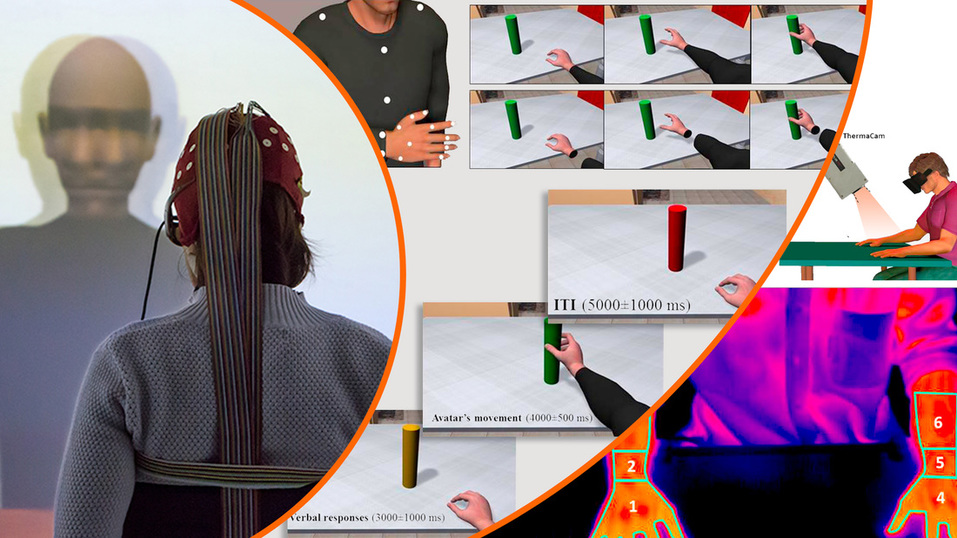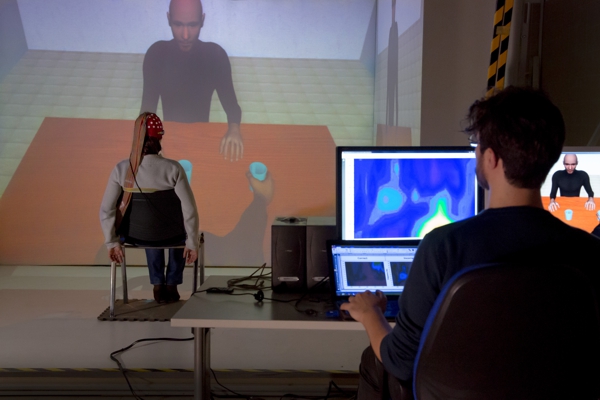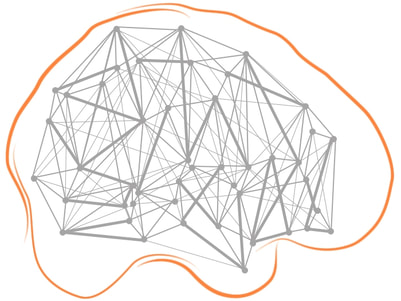ACADEMIC RESEARCH
The research activity of BrainTrends is at the core of cognitive and social neuroscience. Our research interests concern the understanding of the human behavior and the brain functioning in relation to the execution and observation of action and to direct and vicarious experience of pain. These research topics are mainly carried out by using behavioural, psychological and psychophysiological (i.e. electroencephalographic - EEG) measures.
Human brains in virtual scenarios
Recently, our research team has opened a new line of research, which exploits the virtual reality to create ad-hoc scenarios that simulate interpersonal relationships in order to study how our brain embodies a virtual body by exploring the EEG signatures of monitoring the actions of the avatar seen in the first perspective.
This research line is now applied to brain damaged patients.
This research line is now applied to brain damaged patients.
How the brain at rest works
Grounded on recent neuroimaging evidence showing that the spontaneous brain activity at rest, that is in the absence of stimuli or tasks, is organized in large-scale ensembles of brain regions that show correlated ongoing activity
(resting state networks or RSN), the effort of scientists from BrainTrends is to understand how the organization of the resting brain is modified both spatially and temporally during task performance.
Within this theoretical framework, we also address how the intrinsic activity of the brain might predict the individual's attitude and predisposition and in particular our tendency to empathically react to the pain of others.
These research topics are mainly addressed by
Magnetoencephalographic (MEG) and Electroencephalographic (EEG) measures.
(resting state networks or RSN), the effort of scientists from BrainTrends is to understand how the organization of the resting brain is modified both spatially and temporally during task performance.
Within this theoretical framework, we also address how the intrinsic activity of the brain might predict the individual's attitude and predisposition and in particular our tendency to empathically react to the pain of others.
These research topics are mainly addressed by
Magnetoencephalographic (MEG) and Electroencephalographic (EEG) measures.
Training opportunities for basic and applied neuroscience
BrainTrends actively contributes to high level of training on various aspects of basic and applied neuroscience
by means of teaching activity and by organizing seminars and workshops.
by means of teaching activity and by organizing seminars and workshops.
Selected recent pubblications using Braintrends technology (see pubblications page for extensive list)
Fusaro, M., Tieri, G., & Aglioti, S. M. (2019). Influence of cognitive stance and physical perspective on subjective and autonomic reactivity to observed pain and pleasure: An immersive virtual reality study. Consciousness and cognition,67,86-97.
Gandolfo, M., Era, V., Tieri, G., Sacheli, L. M., & Candidi, M. (2019). Interactor's body shape does not affect visuo-motor interference effects during motor coordination. Acta psychologica, 196, 42-50.
Moreau, Q., Candidi, M., Era, V., Tieri, G., & Aglioti, S. M. (2018). Frontal and occipito-temporal Theta activity as marker of error monitoring in Human-Avatar joint performance. bioRxiv,402149.
Aricò, P., Reynal, M., Imbert, J. P., Hurter, C., Borghini, G., Di Flumeri, G., ... & Pozzi, S. (2018, July). Human-machine interaction assessment by neurophysiological measures: a study on professional air traffic controllers. In 2018 40th Annual International Conference of the IEEE Engineering in Medicine and Biology Society (EMBC)(pp. 4619-4622). IEEE.
Era, V., Aglioti, S. M., Mancusi, C., & Candidi, M. (2018). Visuo-motor interference with a virtual partner is equally present in cooperative and competitive interactions. Psychological research,1-13.
Era, V., Candidi, M., Gandolfo, M., Sacheli, L. M., & Aglioti, S. M. (2018). Inhibition of left anterior intraparietal sulcus shows that mutual adjustment marks dyadic joint-actions in humans. Social cognitive and affective neuroscience,13(5), 492-500.
Candidi, M., Sacheli, L. M., Era, V., Canzano, L., Tieri, G., & Aglioti, S. M. (2017). Come together: human–avatar on-line interactions boost joint-action performance in apraxic patients. Social cognitive and affective neuroscience,12(11), 1793-180
Fusaro, M., Tieri, G., & Aglioti, S. M. (2016). Seeing pain and pleasure on self and others: behavioral and psychophysiological reactivity in immersive virtual reality. Journal of neurophysiology,116(6), 2656-2662.
Sacheli, L. M., Candidi, M., Era, V., & Aglioti, S. M. (2015). Causative role of left aIPS in coding shared goals during human–avatar complementary joint actions. Nature communications,6,7544.
Fusaro, M., Tieri, G., & Aglioti, S. M. (2019). Influence of cognitive stance and physical perspective on subjective and autonomic reactivity to observed pain and pleasure: An immersive virtual reality study. Consciousness and cognition,67,86-97.
Gandolfo, M., Era, V., Tieri, G., Sacheli, L. M., & Candidi, M. (2019). Interactor's body shape does not affect visuo-motor interference effects during motor coordination. Acta psychologica, 196, 42-50.
Moreau, Q., Candidi, M., Era, V., Tieri, G., & Aglioti, S. M. (2018). Frontal and occipito-temporal Theta activity as marker of error monitoring in Human-Avatar joint performance. bioRxiv,402149.
Aricò, P., Reynal, M., Imbert, J. P., Hurter, C., Borghini, G., Di Flumeri, G., ... & Pozzi, S. (2018, July). Human-machine interaction assessment by neurophysiological measures: a study on professional air traffic controllers. In 2018 40th Annual International Conference of the IEEE Engineering in Medicine and Biology Society (EMBC)(pp. 4619-4622). IEEE.
Era, V., Aglioti, S. M., Mancusi, C., & Candidi, M. (2018). Visuo-motor interference with a virtual partner is equally present in cooperative and competitive interactions. Psychological research,1-13.
Era, V., Candidi, M., Gandolfo, M., Sacheli, L. M., & Aglioti, S. M. (2018). Inhibition of left anterior intraparietal sulcus shows that mutual adjustment marks dyadic joint-actions in humans. Social cognitive and affective neuroscience,13(5), 492-500.
Candidi, M., Sacheli, L. M., Era, V., Canzano, L., Tieri, G., & Aglioti, S. M. (2017). Come together: human–avatar on-line interactions boost joint-action performance in apraxic patients. Social cognitive and affective neuroscience,12(11), 1793-180
Fusaro, M., Tieri, G., & Aglioti, S. M. (2016). Seeing pain and pleasure on self and others: behavioral and psychophysiological reactivity in immersive virtual reality. Journal of neurophysiology,116(6), 2656-2662.
Sacheli, L. M., Candidi, M., Era, V., & Aglioti, S. M. (2015). Causative role of left aIPS in coding shared goals during human–avatar complementary joint actions. Nature communications,6,7544.



